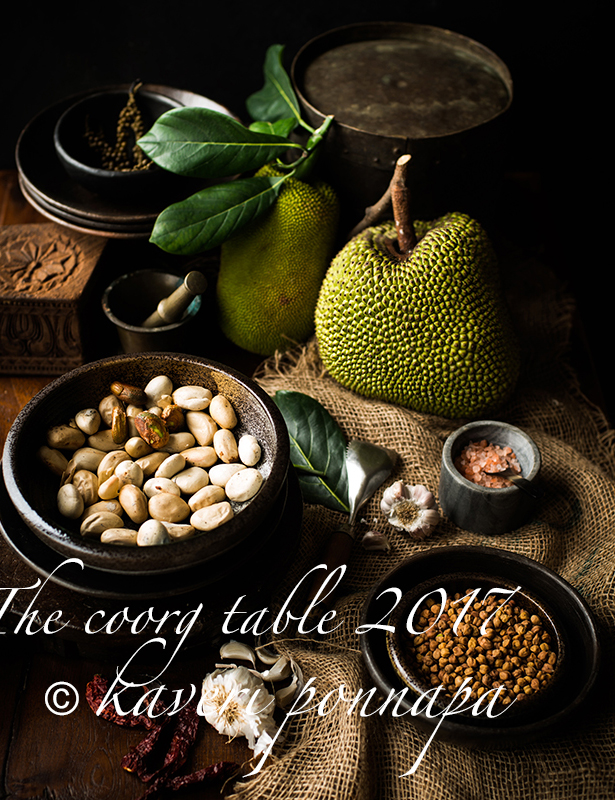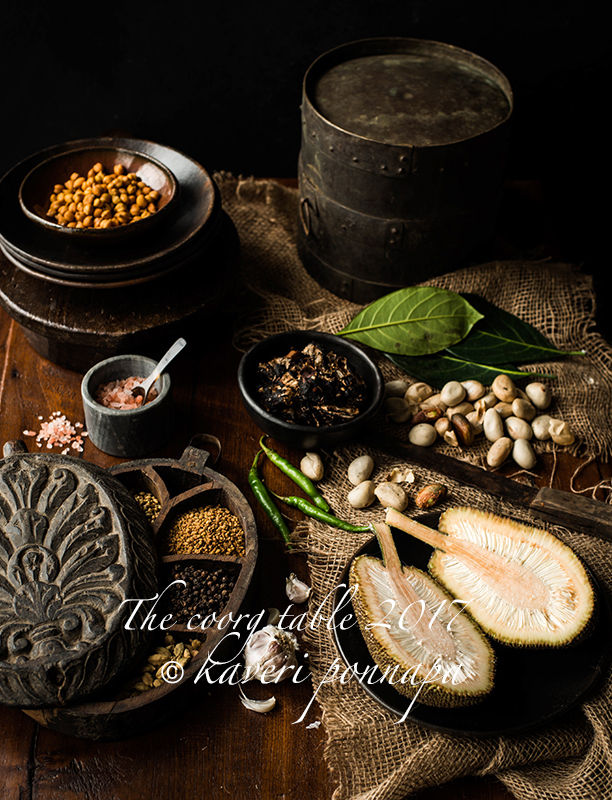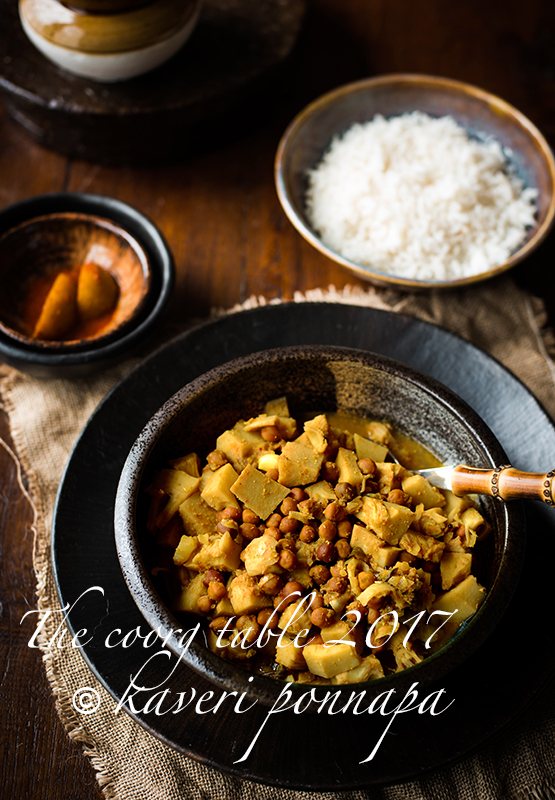Recently, I was going through a collection of Coorg nursery rhymes for very small children recorded way back in 1871, and came across this delightful one:
Chekke kari
Choda, choda beva,
Kumbala kari
Guda, guda beva
The words are very simple: they mimic the sounds made by chunks of jackfruit as they boil in a curry pot, and the bubbling of cubes of pumpkin as it they are cooked into a curry. With charming directness, these words meant for tiny children evoke the warmth of a wood fired kitchen, and the anticipation of comfort and nourishment from these two earthy curries, so familiar in every home.
Before the great herds of wild elephants had been starved out of their forests and came rampaging across coffee plantations, eating everything in their path, you saw a lot of jackfruit growing across Coorg. The trees, when well grown, are tall and extremely attractive, with shiny green leaves and great big clusters of fruit that can grow to enormous sizes, decorating the trunk and branches. Sometimes the fruits contort themselves into fantastic shapes, as they grow between very close set branches, or in the fork of a tree, refusing to give up, portly bellies swelling in all available directions – the sight of a plump jackfruit stuck between the branches of a tree was a favourite way for Coorg poets to describe the situation of someone caught in a difficult situation.
O. W. Barrett, an American botanist, wrote in 1928: “The jaks are such large and interesting fruits and the trees so well behaved that it is difficult to explain the general lack of knowledge concerning them.” But then, he wasn’t talking about Coorg. Here, jackfruit has an almost mythic status. It is eaten at every different stage of its life, cooked or uncooked, ripe or raw, mature seeds cooked when fresh, or dried. It is also an incredibly generous tree: its leaves, roots and bark are used in a whole range of cures in native medicine. Even its complex, spiky skin –a profusion of peaks and steep valleys –has inspired one of the loveliest pieces of Coorg jewellery, a bangle with spikes like the skin of jackfruit. About the honey-sweet, powerfully scented, ripe, golden yellow bulbs, and all that can be made from them, more another time.
The chunks of jackfruit bubbling away in the pot described in the nursery rhyme refer to unripe flesh, cut from a tender young fruit. This has called ‘vegetable meat’, with good reason. Cooked with soaked and drained brown chickpeas, or kidney beans, it makes a rich, dense textured, meaty stew. For a finicky and fickle meat eater like me, a couple of helpings of tender jackfruit curry are as good as the real thing. If you use an earthenware chatti in which to cook it, the results will be even better. Warm spice notes, a sharp tanginess, and this meaty texture blend beautifully together, with soft chickpeas to mash into the mixture with a bowlful of rice. It has been a richly flavoured, easily available favourite for as long as I can remember.
All the jackfruit I ever ate in my childhood was of the indigenous variety, native to the forests of the Western Ghats. That’s what the elephants ate too. They love jackfruit. Now that they have been forced out of the forest, they come in search of food, any food, right up to homes on coffee plantations, and strip whatever fruit they can find from trees. Homeowners often cut jackfruit down even as it grows, nervous about having these huge pachyderms hanging around right outside their front doors. So, soon, maybe there won’t be much native fruit left for the elephants –or for us.
Photo Credits:
All Food Styling: Kaveri Ponnapa
Please look out for the recipe in my upcoming cookbook
Thank you for visiting this page. If you read something that you enjoy, or see an image that you like, please take a moment to write a response. Do look out for the recipes of all the food featured here in my upcoming cookbook.





Jackfruit curry, palya, chips, jackfruit seeds pajji, seed fry no limits..I think there is a huge connection between coorg and jackfruit..I do remember jackfruit’s seeds used to kept above the Stove ( made of mud) in kitchen and in rainy season we used to eat it by frying..the enjoyment at that time nothing can match…words are very less to describe it..Wow..so nice…endless memories is connected with these jackfruits…Thank you..once again for bringing all those memories back…
Hello Kaverappa! I always look forward to hearing about a post from you, there’s always some special image that you share-this time it’s the ‘wole’, the mud fireplace/oven that was part of every home, with its stash of jackfruit seeds above it-the flavour must have been smokey and really delicious….I have only eaten the sun-dried ones, I must figure out a way to dry the seeds over a wood fire, I know it will be worth the effort. Thank you! Warm wishes.Kaveri
I don’t know what is more beautiful, your stories, your food or your pictures. They inspire me so much. Love your blog.
Hello Bhavna, it’s wonderful to hear these words from you, thank you very much for writing. Every post draws on memories, as well as contemporary happenings -the food so much a part of the place, and I always hope that it will be a sort of window into Coorg for both people who have never been there, and others who know it like a part of themselves. I love the ‘Musings’ on your website, and ‘Roohafza’ is still my favourite! Do keep reading. Warm wishes. Kaveri
YUMMMMMMMMM !! The green chakka ( in malayalam) is so overlooked as a real vegetable.
Hi Kishore, welcome back to the Coorg Table! I completely agree with you, it is an overlooked vegetable-so much texture, taste and richness to it. It is delicious in this curry, and I love it in a pickle too. Still trying to perfect that one. The chekke kuru curry, made with the seeds is great too. Best wishes. Kaveri